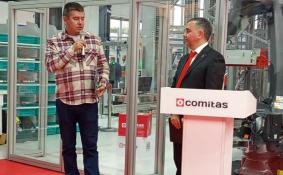Scientific & Practical Journal


Editorial News
Dear readers! We are pleased to present to you the eleventh issue of the journal in 2025. There are a lot of relevant and useful materials in the issue, which, hopefully, will not be ignored.
Dear readers! In September the CeMAT RUSSIA exhibition was held, which showed everyone that innovations and robotics are increasingly penetrating the logistics industry. We can safely say that many technologies are tested here, and only then they go out into the world. However, it is not only CeMAT RUSSIA that demonstrates the prevalence of the digital agenda.
Dear readers! This is the ninth issue of the journal, which turned out to be very rich and diverse. Traditionally, the issue is opened by an analyst. The material by Alina Nasyrova from the Market Guide Agency, dedicated to investments in warehouse complexes in Russia, recalls the importance of developing logistics infrastructure for the integrated development of regions.
PHOTO OF THE WEEK
CITATIONS
Heading:TRANSPORT. TRANSPORTATION
Gudermes is the logistic centre of the two seas
Sergey Delz, Anna Sinitsyna, Dmitry Nedugov, Irina Parkhomenko5 / 2017 | TRANSPORT. TRANSPORTATION
The article discusses the placement of multi-modal terminal and logistics complexes (MTLC) in places of close interaction between different modes of transport. Particular attention is paid to placing MTLC in the logistically unique place ‒ city Gudermes, Chechen Republic which is located at the intersection of the Trans-Caspian route TRACECA and Astrakhan direction of the North-South corridor to the Caspian Sea countries and beyond.
Transportation of Russian natural gas: analysis of major trends and development prospects
Irina Pustokhina, Denis Pustokhin4 / 2017 | TRANSPORT. TRANSPORTATION
The article notes the development of the liquefied natural gas market. The main flows of LNG exports and imports are indicated. Much attention is paid to projects on LNG production in Russia. Marine transport as an alternative to pipeline transport is considered and the dependence of pipeline transport on transit countries is emphasized.
Key words. LNG, natural gas, sea transport, pipeline, transcontinental transportation, tanker-gas carrier, export.
New transit opportunities between East and West
Suren Chibukhchyan4 / 2017 | TRANSPORT. TRANSPORTATION
In the article the development of the transit capacities of countries, transportation between the countries of East and Europe.
Key words. Transit, transport, freight transport, a free economic zone.
Transport Provision Problems in the Arctic Regions of the Russian Federation
Yuri Chizhkov3 / 2017 | TRANSPORT. TRANSPORTATION
Brief up to date characteristics of Arctic transport system is presented, the most hot problems of transport provision in the Arctic regions of Russian Federation are determined, possible ways of improving the present situation are named.
Key words. Arctic, Northern Sea Route, transport provision, GDP (gross domestic product).
The environmental and economic choice of directions of the transport system development in the South of Russia
Leonid Mirotin, Evgeny Lebedev, Elena Chekhovskaya12 / 2016 | TRANSPORT. TRANSPORTATION
The authors of lead changes taking place in recent years in international trade and the organization of its international freight traffic. Indicates a change in the priorities of interregional and international relations, changing the structure of logistics flows, in need of transport services. Shows the value of multi- and intermodal container transport and features of their organization using transport and communication capabilities of southern Russia.
Elaboration of key performance indicators (KPIs) for provision of the sea cargo transportation services
Tatiana Tsenina, Ekaterina Tsenina11 / 2016 | TRANSPORT. TRANSPORTATION
The article discusses the use of new key performance indicators for working with clients managers (KPI) that will allow to eliminate bottlenecks in the organization of sea carriage, to provide the company the opportunity to serve customers better and to gain the sustainable position in the market.
Key words. Sea carriage, international carriage, key performance indicators, freight forwarding company, forwarding services, sea transport, consolidated cargo.
Comparison of the methods to plan goods delivery to the Northern regions of the Russian Federation
Nadezhda Filippova, Vladimir Belyaev11 / 2016 | TRANSPORT. TRANSPORTATION
Reviewed comparison of methods of planning of delivery. Recommendations on the improvement of technological and organizational interoperability of vehicles of delivery of cargoes depending on its type, taking into account the external factors on the proposed floating criteria.
Key words. Planning, carriage of goods, Northern regions of the Russian Federation.
Ways to implement transit potential of the Northern Sea Route in the context of benefits to the Russian economy
Vladimir Petrakov11 / 2016 | TRANSPORT. TRANSPORTATION
This paper covers on the competitive advantages of the Northern Sea Route (NSR) for XXI century in connection with its transit potential.
Key words. The Northern Sea Route, transit potential, competitive advantages, international freight.
Logistics of Urban Passenger Traffic
Leonid Mirotin, Evgeny Lebedev, Alexey Knyazev, Elena Chehovskaya10 / 2016 | TRANSPORT. TRANSPORTATION
The authors show the importance of the urban passenger transport and the characteristics of their organization and performance through the use of logistics concepts and methods. Justifies the need to review the existing forms of organization of this work. The practical results of using the logistic approaches to solving problems, passenger logistics.
Key words. Transport system, passenger transportation, mobility, the trip, the consumer, the loss-making, costs, business structure and logistics.
Port-hub as a Part of the Transport System: Role and Significance
Aleksandr Gapochka10 / 2016 | TRANSPORT. TRANSPORTATION
Use in practice “hub&spoke” model in shipping has marked a new stage in port development, which include the formation of large node centers, so-called “hub ports”. At the same time there is no commonly used general definition of a term “hub port”, and characteristics of hub ports used in literature very seriously. The goal of the article is to set up a definition of a hub port, figure out its role and significance in transport system.
Key words. Hub port, port, transport, logistics, transport system.












